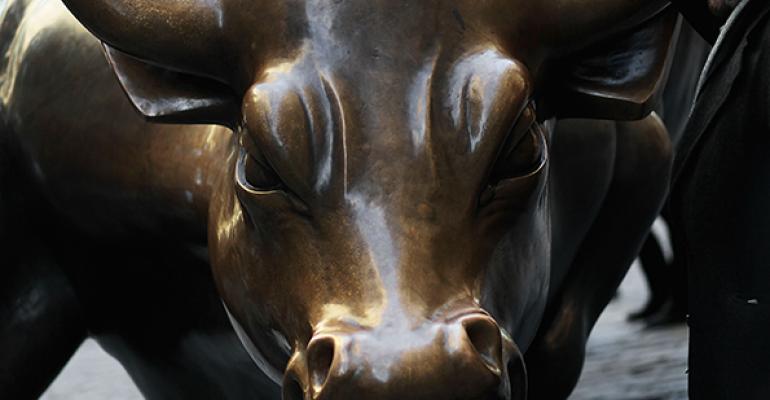By Sarah Ponczek, Vildana Hajric and Elena Popina (Bloomberg)
Bludgeoned for weeks, a bull market is left for dead, its fate seemingly sealed as session after session of red ink show no sign of letting up. Suddenly, at the last second, a rally -- death is averted -- the obituaries go back in the can.
Dec. 26, 2018? Who knows. But such a scenario has played out twice in the past, once in 1998, and again in 2011. So while Wednesday’s momentous surge in U.S. stocks is already bringing out the skeptics, history shows that not every miracle resurrection is a dead cat bounce.
As of Thursday morning, two-thirds of the rally was intact. Futures on the S&P 500 had lost 43 points of the previous session’s 129-point advance as of 7:16 a.m. in New York.
“I don’t know if it’s the all clear signal here but there are some good opportunities,” said Scott Colyer, chairman and chief executive at Advisors Asset Management. “A lot of sentiment indicators hit new lows -- you have a lot of pent-up desire to buy back into a market you’ve been forced out of.”
One thing’s for sure, for investors starved of good news all month, Wednesday brought it coursing back in a flurry. The S&P 500 rallied 5 percent, the Dow Jones Industrial Average added 1,086 points, and the Nasdaq 100 had its best day since 2009. A five-year-old exchange-traded fund tracking momentum shares rose 5.6 percent, its best day ever. All 30 Dow Jones Industrial Average constituents rose, while 99 percent of companies in the S&P 500 finished green.
Why now? After all, investors could’ve used some good news before Christmas, when all they got was pain. In the previous six sessions, the S&P 500 managed to avoid a decline of greater than 1.5 percent just once, extending a December loss that exceeded 14 percent.
A few things might have shaken the bears’ grip. A White House official assured investors that the Federal Reserve chairman won’t get fired, an action Bloomberg News reported over the weekend that President Donald Trump had discussed. Trump made unusually direct comments on the stock market yesterday, saying shares were presenting “a tremendous opportunity to buy.” And a report late in the session that a U.S. delegation will visit Beijing in early January for trade talks gave stocks a final push.
For some investors, it was simply a case of a market getting ahead of itself when everything from hiring to earnings to the economy are still rising.
“We’ve had times when we dropped 20 percent and went into recession but this is an example, so far, where the market realizes a recession isn’t imminent, and going down 20 percent doesn’t make sense,” said Chris Zaccarelli, chief investment officer at the Independent Advisor Alliance. “It’s somewhat telling that we didn’t cross it, we didn’t officially enter into a bear market.”
Everyone on Wall Street knows strong rallies are common in troubled times. In fact, in eight previous bear markets, the S&P 500 had one-day climbs of greater than 2.5 percent more than 120 times as the benchmark plunged from peak to trough, according to data compiled by Bloomberg. From the collapse of Lehman to the financial crisis bottom in March 2009, the S&P 500 rallied more than 4 percent on 13 different occasions.
“Bear markets always serve up some very nasty rallies,” said Doug Ramsey, chief investment officer of Leuthold Weeden Capital Management, which manages about $1.2 billion. “There’s a saying that bear market rallies look better than the real thing so I’d expect at some point here a 3 to 4 percent up day. It’s not unusual at all to see that in a bear market.”
Still, a bull can hope. Consider the 19.4 percent drop from April 29 to October 3 in 2011, for instance. At that bottom, the gauge experienced three days of gains greater than 1.5 percent -- and continued on to its best month in 20 years. That recovery paved the way for the longest bull market ever recorded, the one that was salvaged today.
Something similar happened in 1998, when the benchmark suffered a drop greater than 19 percent, bottoming on Oct. 8, before a 2.6 percent rally spared it from oblivion. From October’s start to the end of January the following year, the gauge surged nearly 25 percent.
Still, for many traders watching their screens explode in green, massive gains are viewed with suspicion.
“This is not the kind of price action you see in normal bull markets,” said Michael Antonelli, equity sales trader at Robert W. Baird. “This is just a face ripping short cover rally. I am 100 percent not saying we are in a situation like 2008 now, but look at October 10, 2008 to October 13, 2008: the market rose nearly 12 percent in one day. October 27 to October 28, 2008, it rose 11 percent.”
To call the bottom, Antonelli is looking for, along with other indicators, at least two consecutive days in which the percentage of stocks rising exceeds 90, an event that happened today. Until then, suspicion will run high.
“I view it with skepticism until it’s proven with a few metrics: volume, breadth, sentiment,” he said. “But right now I just view it skeptically because this isn’t normal price action.”




